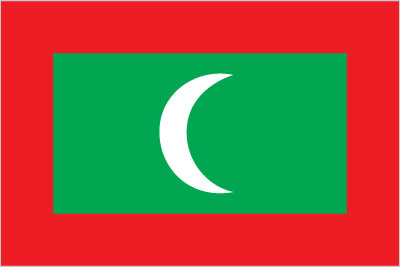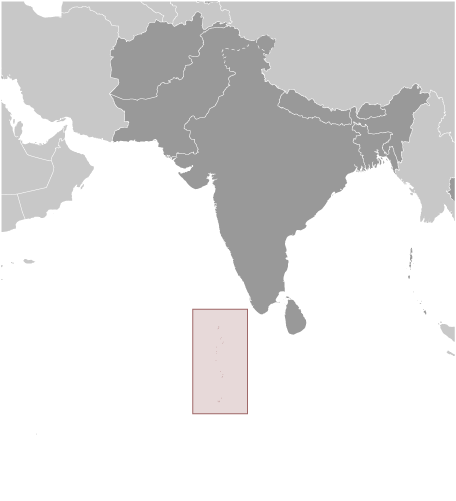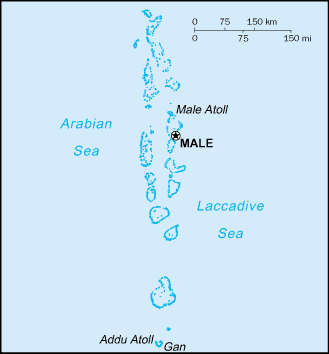|
Economy - overview:
|

|
|
Tourism, Maldives' largest economic activity, accounts for 28% of GDP and more than 60% of foreign exchange receipts. Fishing is the second leading sector, but the fish catch has dropped sharply in recent years. Agriculture and manufacturing continue to play a lesser role in the economy, constrained by the limited availability of cultivable land and the shortage of domestic labor. Lower than expected tourist arrivals and fish exports, combined with high government spending on social needs, subsidies, and civil servant salaries contributed to a balance of payments crisis, which was temporarily eased with a $79.3 million IMF Stand-By agreement. However, after the first two disbursements, the IMF withheld subsequent disbursements due to concerns over Maldives' growing budget deficit, and the government has been seeking other sources of budgetary support ever since. A new Goods and Services Tax (GST) on tourism introduced in January 2011, on general goods and services in October 2011, and a new Business Profit Tax introduced in July 2011 have provided a boost to revenue. Economic growth slowed to 3.4% of GDP in 2012, compared to 7.0% in 2011 because of slower tourist arrivals and weak global conditions. Diversifying the economy beyond tourism and fishing, reforming public finance, increasing employment opportunities, and combating corruption, cronyism, and a growing drug problem are major near-term challenges facing the government. Gross foreign reserves at the end of November 2012 were approximately $356 million, compared with $326 million in 2011, and were sufficient to finance only 2.6 months of imports. Over the longer term Maldivian authorities worry about the impact of erosion and possible global warming on their low-lying country; 80% of the area is 1 meter or less above sea level.
|
|
|
GDP (purchasing power parity):
|

|
|
$2.974 billion (2012 est.)
country comparison to the world: 181
$2.876 billion (2011 est.)
$2.688 billion (2010 est.)
note:
data are in 2012 US dollars
|
|
|
GDP (official exchange rate):
|

|
|
$1.537 billion (2012 est.)
|
|
|
GDP - real growth rate:
|

|
|
3.4% (2012 est.)
country comparison to the world: 101
7% (2011 est.)
5.7% (2010 est.)
|
|
|
GDP - per capita (PPP):
|

|
|
$8,700 (2012 est.)
country comparison to the world: 125
$8,700 (2011 est.)
$8,400 (2010 est.)
note:
data are in 2012 US dollars
|
|
|
GDP - composition by sector:
|

|
|
agriculture: 3%
industry:
17%
services:
80% (2012 est.)
|
|
|
Labor force:
|

|
|
152,500 (2010)
country comparison to the world: 177
|
|
|
Labor force - by occupation:
|

|
|
agriculture: 11%
industry:
23%
services:
65% (2006 est.)
|
|
|
Unemployment rate:
|

|
|
28% (2012 est.)
country comparison to the world: 176
14.5% (2010 est.)
|
|
|
Population below poverty line:
|

|
|
16% (2008)
|
|
|
Household income or consumption by percentage share:
|

|
|
lowest 10%: 1.2%
highest 10%:
33.3% (FY09/10)
|
|
|
Budget:
|

|
|
revenues: $638 million
expenditures:
$917 million (2012 est.)
|
|
|
Taxes and other revenues:
|

|
|
41.5% of GDP (2012 est.)
country comparison to the world: 43
|
|
|
Budget surplus (+) or deficit (-):
|

|
|
-18.1% of GDP (2012 est.)
country comparison to the world: 215
|
|
|
Inflation rate (consumer prices):
|

|
|
5.1% (2012 est.)
country comparison to the world: 143
16.7% (2011 est.)
|
|
|
Central bank discount rate:
|

|
|
7% (31 December 2012 est.)
country comparison to the world: 43
6.96% (31 December 2011 est.)
|
|
|
Commercial bank prime lending rate:
|

|
|
10.5% (31 December 2012 est.)
country comparison to the world: 88
10.2% (31 December 2011 est.)
|
|
|
Stock of narrow money:
|

|
|
$547.1 million (31 December 2012 est.)
country comparison to the world: 158
$531.4 million (31 December 2011 est.)
|
|
|
Stock of broad money:
|

|
|
$1.298 billion (31 December 2012 est.)
country comparison to the world: 161
$1.237 billion (31 December 2011 est.)
|
|
|
Stock of domestic credit:
|

|
|
$1.559 billion (31 December 2012 est.)
country comparison to the world: 143
$1.601 billion (31 December 2011 est.)
|
|
|
Market value of publicly traded shares:
|

|
|
$555 million (31 December 2011 est.)
|
|
|
Agriculture - products:
|

|
|
coconuts, corn, sweet potatoes; fish
|
|
|
Industries:
|

|
|
tourism, fish processing, shipping, boat building, coconut processing, woven mats, rope, handicrafts, coral and sand mining
|
|
|
Industrial production growth rate:
|

|
|
-0.9% (2004 est.)
country comparison to the world: 152
|
|
|
Current account balance:
|

|
|
-$600 million (2012 est.)
country comparison to the world: 100
$437 million (2011 est.)
|
|
|
Exports:
|

|
|
$283 million (2012 est.)
country comparison to the world: 180
$316 million (2011 est.)
|
|
|
Exports - commodities:
|

|
|
fish
|
|
|
Exports - partners:
|

|
|
France 19.2%, Thailand 18.7%, UK 10.4%, Sri Lanka 10.1%, India 8.5%, Italy 8.2%, Germany 4.7% (2011)
|
|
|
Imports:
|

|
|
$1.406 billion (2012 est.)
country comparison to the world: 173
$1.314 billion (2011 est.)
|
|
|
Imports - commodities:
|

|
|
petroleum products, clothing, intermediate and capital goods
|
|
|
Imports - partners:
|

|
|
Singapore 23.2%, UAE 18%, India 8.7%, China 7.1%, Malaysia 6.9%, Sri Lanka 5.3%, Thailand 4.9% (2011)
|
|
|
Reserves of foreign exchange and gold:
|

|
|
$356 million (30 November 2012 est.)
country comparison to the world: 152
$326 million (30 November 2011 est.)
|
|
|
Debt - external:
|

|
|
$890.8 million (2012 est.)
country comparison to the world: 160
$684.2 million (2011 est.)
|
|
|
Exchange rates:
|

|
|
rufiyaa (MVR) per US dollar -
15.39 (2011)
14.602 (2011)
12.8 (2008)
12.8 (2007)
|
|
|
Fiscal year:
|

|
|
calendar year
|
|
|
|





 )
)



